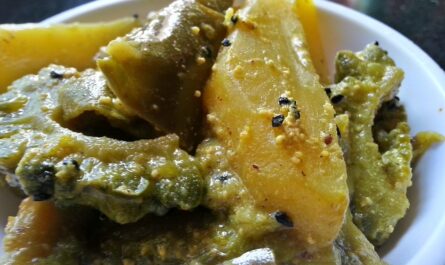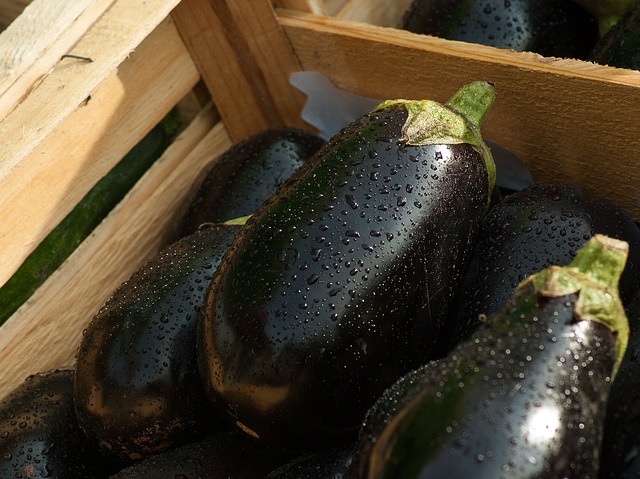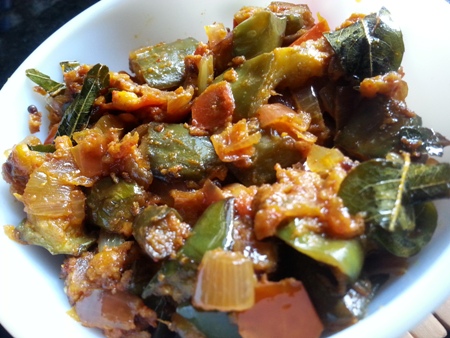
All about eggplant gives you valuable tips on how to buy, store and cook eggplants.
Eggplant (solanum melongena) belongs to the nightshade family as do tomatoes, potatoes and bell peppers. The popular variety of eggplant or aubergine comes in a signature deep purple colour, with the glossy skin encasing white flesh dotted with tiny, edible seeds. Eggplants are widely used in Indian cooking.
All About Eggplant Buying, Storing and Cooking:
Eggplants can be cooked whole, cubed, or sliced, and you can fry, grill, bake, stew, roast or steam them. Studies suggest steaming eggplants is the best way to preserve their antioxidant levels.
All about eggplant helps you avoid common eggplant buying, storing and cooking mistakes.
All About Eggplant Buying Tips:
- Select eggplants with a vibrant, smooth glossy skin that’s free of scars, bruises and discoloration – an indication that the flesh beneath is damaged and possibly gone bad.
- Do not pick eggplants with dull skin, soft spots or brown blemishes – a sign of poor quality.
- Avoid eggplants with wrinkled, loose skin – a sign that the eggplants are not fresh and will taste bitter.
- Carefully inspect the eggplant stem and cap (calyx) to see if they appear fresh, green and mold-free and not dry, discoloured or brown. A stout, firm and green stalk means the vegetable was recently harvested.
- Choose eggplants that appear firm and heavy for their size – such eggplants are in good condition and fresh. Avoid eggplants that feel light as they may be over-mature.
- Small or medium sized eggplants are always better – the younger the eggplant, the thinner its skin, the fewer the seeds, the sweeter the taste and the more tender its flesh will be. As the eggplant matures, its flesh turns bitter and will have more seeds.
- Perfectly ripe eggplants will be slightly firm. Gently but firmly press the eggplant skin with your thumb. If it creates a light indent but springs back to shape once you release pressure, the eggplant is just ripe. If the depression remains, it is too old and overripe.
Eggplant Storing Tips:
- Eggplants are perishable items, being sensitive to heat as well as cold. They don’t store long.
- You can at the most leave eggplants at room temperature for 1-2 days. Keep them uncovered in a cool dark place. Ideally, it’s best to store them in the fridge.
- Since eggplants have a relatively short shelf life, choose ones as fresh as possible and try to use them within a day.
- Eggplants tend to bruise easily, so you need to handle them quite gingerly.
- If store-bought eggplants come shrink-wrapped, take out the plastic wrapper, cover eggplants in paper towels, place them in a perforated plastic bag and store them in the refrigerator vegetable basket. They will keep for up to 4-5 days.
- If picked straight from the garden, eggplants will keep for up to 7 days in the refrigerator.
- If you cut eggplants before storing, they will decay quickly.
- Cooked eggplants can be stored in the refrigerator for up to 3 days (when reheating, they tend to get mushy).
- You can freeze cooked eggplants up to six months in puree form (just add some lemon juice to prevent discoloration).
- To freeze eggplants, first boil water in a large vessel. Keep some ice and water ready in another container, large enough to hold the eggplant. Peel and slice the eggplant into 1/3-inch thickness. Quickly drop slices into boiling water and keep covered for 3 minutes. Remove slices with a slotted spoon and place them in ice water to stop further cooking. Cool, drain slices and pat them dry. Use a plastic wrap to separate slices, place them into freezer bags, force out all the air and seal the bags tightly.
- Raw eggplant should not be stored at temperatures below 50 F (10 C).
Eggplant Cooking Tips:
- Wash eggplants thoroughly under cold water before using them.
- Use a sharp knife to trim the eggplant stalk.
- Use a stainless steel knife to cut eggplants instead of a carbon steel knife. This prevents the material from reacting with phytochemicals in eggplants, which can cause them to turn black.
- Once you cut eggplants, the flesh starts to darken with exposure to air. So, immerse cut eggplant pieces in salt water or sprinkle lemon juice on them to prevent discolouration.
- To tenderise eggplants and to reduce their bitterness, cut them into pieces and sprinkle salt over them. Allow the salted eggplant slices to sit for 30 minutes. This “sweating” process draws out moisture from the eggplant along with the components which give it a bitter taste. This also makes the pieces soak up less oil when cooking. Rinse the eggplant pieces and pat dry before cooking.
- To leach out moisture and reduce the absorbency of eggplants, parboil slices for a couple of minutes. Thoroughly drain slices and pat them dry with paper towels prior to cooking.
- You can steam, fry, sauté, roast, bake, boil, stir-fry, microwave, broil or stuff eggplants.
- Eggplant skin and seeds are edible. However, in some eggplants, especially large ones, bitterness is concentrated right under the skin; so peeling it will also work.
- Eggplants have a sponge-like flesh which tends to soak up oils and juices. To avoid absorbing too much oil during cooking, dip eggplant slices in flour and beaten egg, and coat with bread crumbs before frying.
- To avoid overcooking eggplants, add them to soups and stews in the last ten minutes of cooking.
- If baking a whole eggplant, pierce the eggplant skin all over with a fork so it doesn’t burst.
- Avoid using aluminium cookware when making eggplant dishes as it will lead to discoloration.
- To remove excess moisture, microwave eggplant slices on high for about 4-6 minutes, take them out, cover and allow to stand for 1-2 minutes. Press slices lightly with paper towels to soak up moisture.
Eggplants come in so many varieties and sizes and there are so many different ways to cook them. All about eggplant helps you pick the best eggplants, store them in good condition till ready to use and prepare them carefully for cooking.


